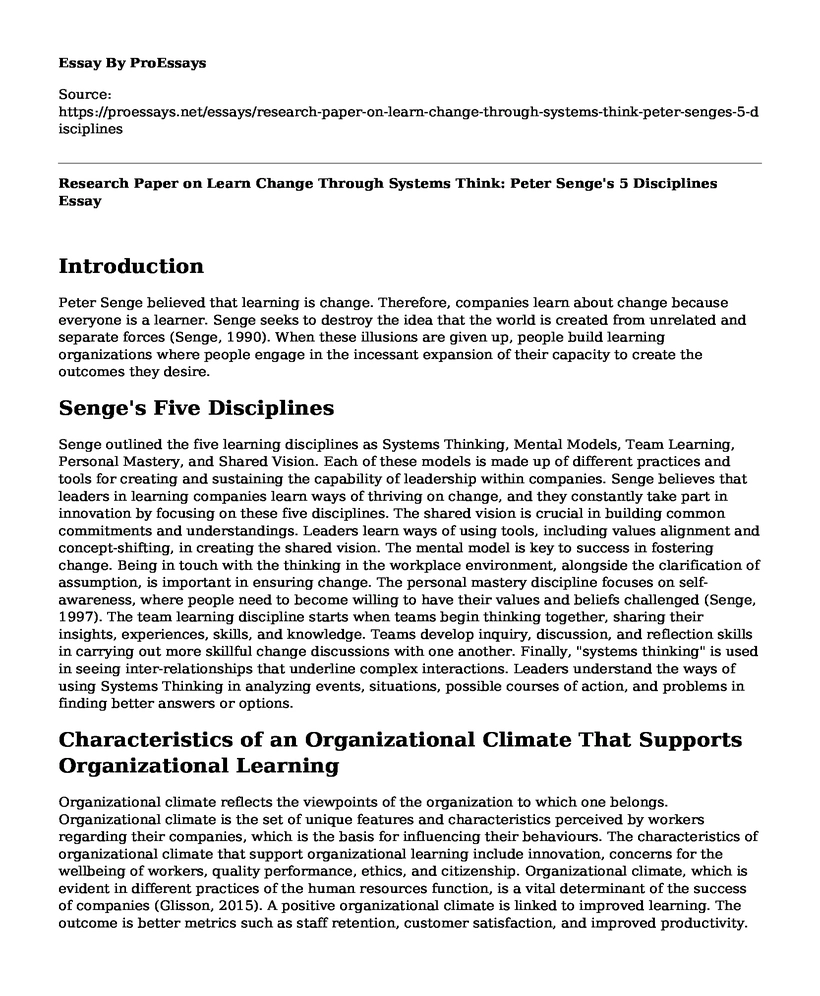Introduction
Peter Senge believed that learning is change. Therefore, companies learn about change because everyone is a learner. Senge seeks to destroy the idea that the world is created from unrelated and separate forces (Senge, 1990). When these illusions are given up, people build learning organizations where people engage in the incessant expansion of their capacity to create the outcomes they desire.
Senge's Five Disciplines
Senge outlined the five learning disciplines as Systems Thinking, Mental Models, Team Learning, Personal Mastery, and Shared Vision. Each of these models is made up of different practices and tools for creating and sustaining the capability of leadership within companies. Senge believes that leaders in learning companies learn ways of thriving on change, and they constantly take part in innovation by focusing on these five disciplines. The shared vision is crucial in building common commitments and understandings. Leaders learn ways of using tools, including values alignment and concept-shifting, in creating the shared vision. The mental model is key to success in fostering change. Being in touch with the thinking in the workplace environment, alongside the clarification of assumption, is important in ensuring change. The personal mastery discipline focuses on self-awareness, where people need to become willing to have their values and beliefs challenged (Senge, 1997). The team learning discipline starts when teams begin thinking together, sharing their insights, experiences, skills, and knowledge. Teams develop inquiry, discussion, and reflection skills in carrying out more skillful change discussions with one another. Finally, "systems thinking" is used in seeing inter-relationships that underline complex interactions. Leaders understand the ways of using Systems Thinking in analyzing events, situations, possible courses of action, and problems in finding better answers or options.
Characteristics of an Organizational Climate That Supports Organizational Learning
Organizational climate reflects the viewpoints of the organization to which one belongs. Organizational climate is the set of unique features and characteristics perceived by workers regarding their companies, which is the basis for influencing their behaviours. The characteristics of organizational climate that support organizational learning include innovation, concerns for the wellbeing of workers, quality performance, ethics, and citizenship. Organizational climate, which is evident in different practices of the human resources function, is a vital determinant of the success of companies (Glisson, 2015). A positive organizational climate is linked to improved learning. The outcome is better metrics such as staff retention, customer satisfaction, and improved productivity.
Organizational Climate and Senge's Disciplines
Companies must offer activities for workers alongside providing the climate and environment that enhance or prevent learning. The five disciplines by Senge point to the factors that contribute to learning within organizations. These factors are people influencing the learning process such as supportive top and middle management, operating and mission procedures that guide policy, and the shared values or cultures framing actions of an organization (Glisson, 2015). A creative company climate is important in learning organizations. Senge's disciplines are vital in forming an improved organizational climate, especially influencing the actions of top leaders. For example, leaders have better decision making and problem solving skills that improve the overall productivity within the company.
Conclusion
The ideas of Senge about organizational learning show that change is a constantly evolving process that must be embraced by every company. The right approach and mindset for leaders are very crucial in achieving the best organizational results. The best organizational characteristics, such as innovation and improved communication, are central in achieving the best organizational climate.
References
Glisson, C. (2015). The role of organizational culture and climate in innovation and effectiveness. Human service organizations: management, leadership & governance, 39(4), 245-250. Retrieved from https://www.ncbi.nlm.nih.gov/pmc/articles/PMC5008450/
Senge, P. (1990). Peter Senge and the learning organization. Rcuperado de. Retrieved from http://citeseerx.ist.psu.edu/viewdoc/download?doi=10.1.1.475.9451&rep=rep1&type=pdf
Senge, P. M. (1997). The fifth discipline. Measuring Business Excellence, 1(3), 46-51. Retrieved from http://www.e-reading.bz/bookreader.php/112324/Senge_-_Pyataya_disciplina.pdf
Cite this page
Research Paper on Learn Change Through Systems Think: Peter Senge's 5 Disciplines. (2023, Feb 27). Retrieved from https://proessays.net/essays/research-paper-on-learn-change-through-systems-think-peter-senges-5-disciplines
If you are the original author of this essay and no longer wish to have it published on the ProEssays website, please click below to request its removal:
- A Reflective Report
- Personal Request of a Better Grade
- Essay Sample on Motivated Students: Feeling Valued and Encouraged
- Essay Example on Learning to Write and Spell: A Foundation for Language Skills
- Vivid Dream: Scholarship to Join the Michigan State University Essay
- Essay Example on Unlock Literacy Skills With English Literature: A Must for Schools
- Mitigating Drug Abuse in Schools: How To Create Awareness & Change Student Behavior - Essay Sample







